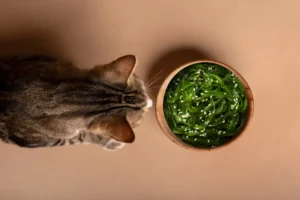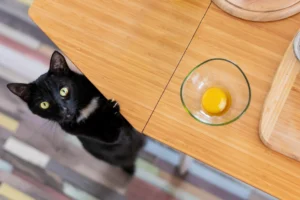Disclaimer: Always check with your vet on what “human foods” your cat can and cannot eat as information may vary based on their dietary needs and health conditions.
Watermelon is a healthy refreshing fruit that’s widely enjoyed by humans. As obligate carnivores, can the same be said for cats?
Read on to learn more about whether watermelon is good for cats, how much should they be eating and more.
Table of Contents
Is watermelon good for cats?
Watermelon can be a safe and hydrating treat for cats in moderation. Here are some benefits:
- Hydration: Watermelon is about 92% water, making it a refreshing snack, especially in hot weather.
- Low in Calories: It’s low in calories, which is helpful for maintaining a healthy weight.
- Vitamins: Watermelon contains vitamins A, B6, and C, which can support overall health.
However, not all cats will enjoy the taste, and some may have sensitive stomachs. Always remove seeds and rind, and introduce watermelon gradually to see how your cat reacts. If your cat experiences any digestive issues, it’s best to avoid giving them watermelon. It’s also not advisable to feed watermelon to diabetic or obese cats as the fruit contains a high amount of natural sugar.
Is watermelon bad for cats?
Watermelon is not bad for the obligate carnivore cats are, but here are some pointers if you’re thinking whether to let your cat try some watermelon:
Give in moderation
While watermelon can be a refreshing treat, it should only be given in small amounts. Too much fruit can lead to digestive upset, including diarrhoea.
Remove seeds and rind
Always remove the seeds and rind before offering watermelon to your cat. The seeds contain cyanide can pose a choking hazard, and the rind is difficult for cats to digest.
Individual reactions
Some cats may not like the taste or may have a sensitive stomach. If your cat shows any signs of distress, such as vomiting or diarrhoea, after eating watermelon, it’s best to stop giving it to them.
NOT for cats with diabetes or are overweight
Watermelon could be bad for cats that cannot tolerate fluctuations in sugars.
In summary, watermelon is considered safe for healthy cats, but it’s not necessary to feed it to them.
How much watermelon can a cat eat?
Even though watermelon can be a sweet and hydrating treat for your cat, they should only be given a small, bite-sized square of the flesh with the seeds and rind removed. A general rule of thumb is that treats should not exceed 10% of their total daily caloric intake.
Intravenous (IV) fluids
IV fluids may be provided to help flush the toxins from the system, maintain hydration, and support kidney function
Anti-nausea medications
to help manage vomiting
Anti-seisure medications
if the cat is experiencing seizures or severe tremors.
Heart medications
if there are signs of cardiovascular issues.
Monitoring
The vet may want to monitor your cat’s heart rate, blood pressure, and overall condition to ensure there are no severe complications.
How to tell when a cat has had too much watermelon?
If your cat has eaten too much watermelon (or fruit), they may show some digestive symptoms or other signs of discomfort. Here’s what to watch for:
- Digestive upset: Diarrhoea, loose stools or vomiting
- Lethargy: Your cat seems more tired than usual if their stomach is bothering them
- Reduced appetite: They might avoid food (even their favourite treats) if they’re feeling bloated or nauseous
- Excessive Drooling: This can happen if they feel queasy
- Dehydration: They might lose fluids from diarrhoea or vomiting, so watch for signs of dehydration, like dry gums or reduced skin elasticity.
If your cat shows any of these signs, keep them hydrated and avoid offering any more watermelon or treats for a day or two. If symptoms are severe or don’t resolve within 24 hours, it’s best to consult your vet for advice.
How often can cats eat watermelon?
Cats can enjoy watermelon as an occasional treat, ideally no more than once or twice a month. Since cats are obligate carnivores, their digestive systems aren’t designed to process fruits regularly. Here are some tips for offering watermelon in moderation:
- Limit treats to 10% of total diet: Treats, including watermelon, should make up no more than 10% of their total daily calories.
- Balance variety: If your cat enjoys other safe treats, consider rotating them to avoid offering fruit too frequently.
If your cat seems to tolerate fruit well, giving them a small amount occasionally is a nice way to add variety—just remember to keep the portions small and infrequent.
Also, since cats lack the taste buds to process sweet flavours, they’re likely more attracted to the moisture or texture rather than the fruit. And some may even ignore it completely and opt for meat-based treats instead!
How to feed your cat watermelon?
Follow these steps to help ensure watermelon are a safe, enjoyable snack for your cat:
Wash and peel:
Wash the watermelon thoroughly and remove the rind
Remove the seeds
Ensure all seeds are removed, as they can be a choking hazard and contain cyanide in larger amounts.
Cut into tiny pieces
Slice the watermelon flesh into small, bite-sized pieces appropriate for your cat's size. Aim for pieces that are about 1-2 teaspoons for small to medium cats and up to 1 tablespoon for larger cats.
Introduce slowly
Offer just one small piece at first, especially if this is your cat’s first time trying watermelon. Watch for any reactions or signs of digestive upset.
Serve as a treat:
Avoid mixing watermelon with their regular food. Serve it as a treat on its own to prevent overeating and to monitor for reactions.
Limit frequency
Remember to only offer watermelon as an occasional treat, once or twice a month at most.











